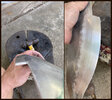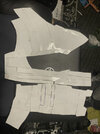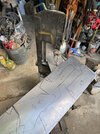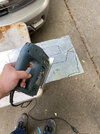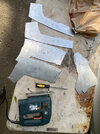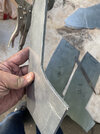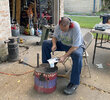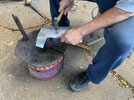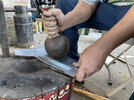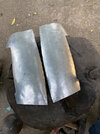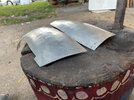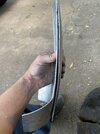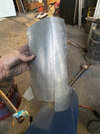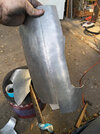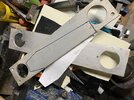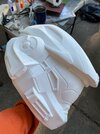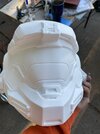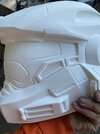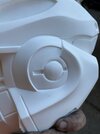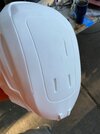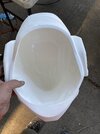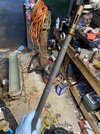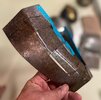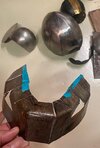Well, not exactly my first armor build. I've been building steel armor for medieval reenactment groups since 1990....but it's my first HALO armor build, and my first large aluminum project....and my first project to share here on the forums! Aluminum works significantly different than steel!
I want to do a full Noble 6 rig this Fall. I'm starting with the Mark V(B) helmet. Similar to modeling for a printer, I break the project down into individual components. Also, this will be done with a base helmet, to which a second "skin" gets attached to create the thick parts. I don't have aluminum welding capability, so I'll be using blind rivets that will be blended in to be "invisible". I'll have some aluminum thin bar sections used periodically to create something to rivet sheet metal sections to. This will make more sense once I get into that part of it and you seethe pics.
The top of the helm is being done in 1/8" 6061 aluminum. This is a bitch to shape into complex curves...but I want it thick so I can gouge/cut different shapes and contours into it as needed. That, and I know I'll be doing stupid stuff with friends and it needs to be impact resilient! The rest of the helm will be 0.080" 6061 and the remainder of the armor will be 0.063" aluminum. The .063 shapes much easier and doesn't work harden as fast.
First pic is the raw stock for the helm along with a couple medieval helms I used as a sizing guide for my head. I made a paper model, then cut it apart and used this to estimate the pattern on the aluminum. This is a bit of black magic, as I'm not experienced in stretch rates of Al. I oversized it a hair since it's easier to trim some off, than to add it back in!



I used my 30 yr old "Ye Ole dishing stump" with a 12 lb ball to start the curves. I pretty much work the metal between various curvature depressions in the stump and with various size hammers/forms to get an even compound curve.

Here's some progression shots of what I got done. This was only about 45 minutes of work.....but It's been several years since I've done this and I might need a week to recover now!

I over curved this a hair, but the next step will be smoothing it out on a pneumatic planishing hammer which will take a little bit of the curve back out of it. I'll put it in one of my heat treating ovens to anneal and stress relieve it first, otherwise it may start cracking out, then again after planishing, then put the final curves in it, Next will be the side plates, which have very slight curves and should go pretty quick. The lower portion of the helmet will definitely be the challenging part. I did a mock up of the front lower half in paper, and although complex, its pretty straight forward. I'm still figuring out the curved portions over the ear sections. Worst case, I could always cast them, I have tons of aluminum shavings from my MA-40 build I could melt down!
Started raining again here in Houston......hopefully it'll be clear this weekend and I can get more done!
I want to do a full Noble 6 rig this Fall. I'm starting with the Mark V(B) helmet. Similar to modeling for a printer, I break the project down into individual components. Also, this will be done with a base helmet, to which a second "skin" gets attached to create the thick parts. I don't have aluminum welding capability, so I'll be using blind rivets that will be blended in to be "invisible". I'll have some aluminum thin bar sections used periodically to create something to rivet sheet metal sections to. This will make more sense once I get into that part of it and you seethe pics.
The top of the helm is being done in 1/8" 6061 aluminum. This is a bitch to shape into complex curves...but I want it thick so I can gouge/cut different shapes and contours into it as needed. That, and I know I'll be doing stupid stuff with friends and it needs to be impact resilient! The rest of the helm will be 0.080" 6061 and the remainder of the armor will be 0.063" aluminum. The .063 shapes much easier and doesn't work harden as fast.
First pic is the raw stock for the helm along with a couple medieval helms I used as a sizing guide for my head. I made a paper model, then cut it apart and used this to estimate the pattern on the aluminum. This is a bit of black magic, as I'm not experienced in stretch rates of Al. I oversized it a hair since it's easier to trim some off, than to add it back in!
I used my 30 yr old "Ye Ole dishing stump" with a 12 lb ball to start the curves. I pretty much work the metal between various curvature depressions in the stump and with various size hammers/forms to get an even compound curve.
Here's some progression shots of what I got done. This was only about 45 minutes of work.....but It's been several years since I've done this and I might need a week to recover now!
I over curved this a hair, but the next step will be smoothing it out on a pneumatic planishing hammer which will take a little bit of the curve back out of it. I'll put it in one of my heat treating ovens to anneal and stress relieve it first, otherwise it may start cracking out, then again after planishing, then put the final curves in it, Next will be the side plates, which have very slight curves and should go pretty quick. The lower portion of the helmet will definitely be the challenging part. I did a mock up of the front lower half in paper, and although complex, its pretty straight forward. I'm still figuring out the curved portions over the ear sections. Worst case, I could always cast them, I have tons of aluminum shavings from my MA-40 build I could melt down!
Started raining again here in Houston......hopefully it'll be clear this weekend and I can get more done!




